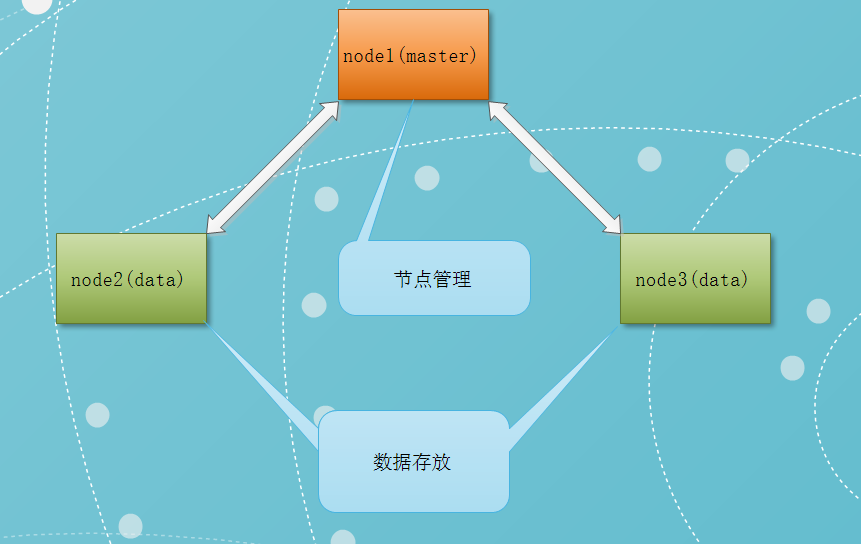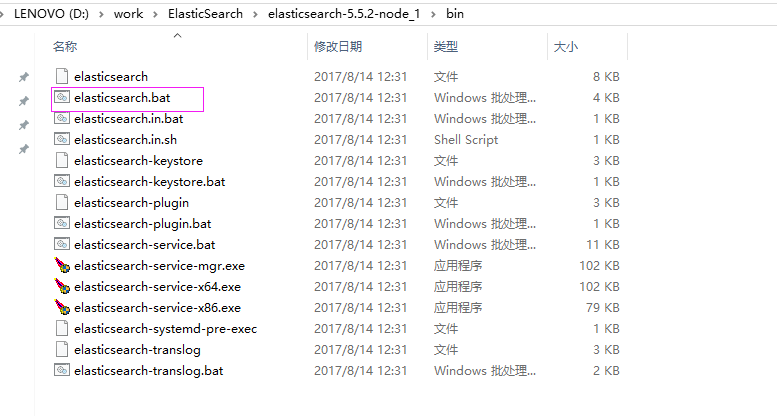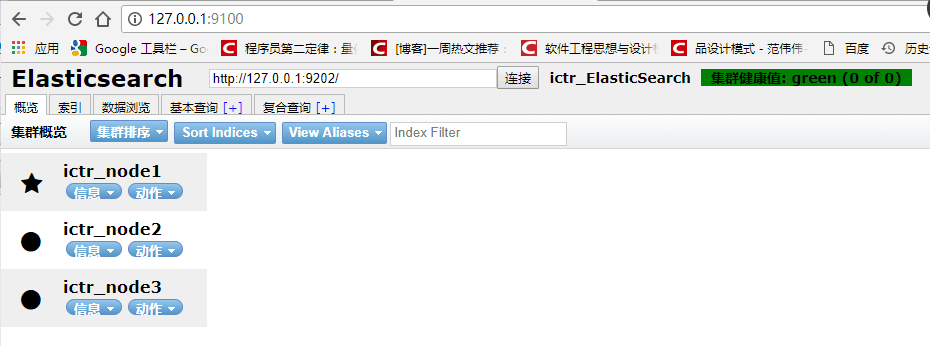本文介绍单机多节点的实例部署情况
1、实验拓扑图
我们实验三个节点,一个主节点,两个从节点

2、单机多节点配置
elasticsearch集群配置比较简单,只需把每个节点的cluster name设置成相同的,es启动时会自动发现同一网段内相同cluster name的节点自动加入到集群中。
要做到单机上开多个实例,需要修改ES的默认配置,以下是一些配置要点:

node.max_local_storage_nodes
这个配置限制了单节点上可以开启的ES存储实例的个数,我们需要开多个实例,因此需要把这个配置写到配置文件中,并为这个配置赋值为2或者更高。
http.port
这个配置是elasticsearch对外提供服务的http端口配置,默认情况下ES会取用9200~9299之间的端口,如果9200被占用就会自动使用9201,在单机多实例的配置中这个配置实际是不需要修改的。
transport.tcp.port
这个配置指定了elasticsearch集群内数据通讯使用的端口,默认情况下为9300,与上面的http.port配置类似,ES也会自动为已占用的端口选择下一个端口号。我们可以将第一个实例的tcp传输端口配置为9300,第二实例配置为9301
把下载解压lasticsearch-5.5.2目录复制两份,三个文件夹分别命名为elasticsearch-5.5.2-node_1 elasticsearch-5.5.2-node_2 elasticsearch-5.5.2-node_3 按照上边的配置信息修改各个节点elasticsearch.yml配置文件

elasticsearch-5.5.2-node_1的elasticsearch.yml配置如下:
# ======================== Elasticsearch Configuration ========================= # # NOTE: Elasticsearch comes with reasonable defaults for most settings. # Before you set out to tweak and tune the configuration, make sure you # understand what are you trying to accomplish and the consequences. # # The primary way of configuring a node is via this file. This template lists # the most important settings you may want to configure for a production cluster. # # Please consult the documentation for further information on configuration options: # https://www.elastic.co/guide/en/elasticsearch/reference/index.html # # ---------------------------------- Cluster ----------------------------------- # # Use a descriptive name for your cluster: # cluster.name: ictr_ElasticSearch # # ------------------------------------ Node ------------------------------------ # # Use a descriptive name for the node: # #换个节点名字 node.name: ictr_node1 node.master: true # # Add custom attributes to the node: # node.attr.rack: r1 # # #这个配置限制了单节点上可以开启的ES存储实例的个数,我们需要开多个实例,因此需要把这个配置写到配置文件中,并为这个配置赋值为2或者更高 node.max_local_storage_nodes: 3 # ----------------------------------- Paths ------------------------------------ # # Path to directory where to store the data (separate multiple locations by comma): # #path.data: /path/to/data # # Path to log files: # #path.logs: /path/to/logs # # ----------------------------------- Memory ----------------------------------- # # Lock the memory on startup: # #bootstrap.memory_lock: false #bootstrap.system_call_filter: false # # Make sure that the heap size is set to about half the memory available # on the system and that the owner of the process is allowed to use this # limit. # # Elasticsearch performs poorly when the system is swapping the memory. # # ---------------------------------- Network ----------------------------------- # # Set the bind address to a specific IP (IPv4 or IPv6): # network.host: 127.0.0.1 # # Set a custom port for HTTP: # http.port: 9200 # transport.tcp.port: 9301 # For more information, consult the network module documentation. # # --------------------------------- Discovery ---------------------------------- # # Pass an initial list of hosts to perform discovery when new node is started: # The default list of hosts is ["127.0.0.1", "[::1]"] # #discovery.zen.ping.unicast.hosts: ["127.0.0.1:9301"] #候选主节点地址 # # Prevent the "split brain" by configuring the majority of nodes (total number of master-eligibl #e nodes / 2 + 1):# discovery.zen.minimum_master_nodes: 1 # # For more information, consult the zen discovery module documentation. # # ---------------------------------- Gateway ----------------------------------- # # Block initial recovery after a full cluster restart until N nodes are started: # #gateway.recover_after_nodes: 3 # # For more information, consult the gateway module documentation. # # ---------------------------------- Various ----------------------------------- # # Require explicit names when deleting indices: # #action.destructive_requires_name: true http.cors.enabled: true http.cors.allow-origin: "*"
elasticsearch-5.5.2-node_2和elasticsearch-5.5.2-node_2类似,的elasticsearch.yml配置如下:
# ======================== Elasticsearch Configuration ========================= # # NOTE: Elasticsearch comes with reasonable defaults for most settings. # Before you set out to tweak and tune the configuration, make sure you # understand what are you trying to accomplish and the consequences. # # The primary way of configuring a node is via this file. This template lists # the most important settings you may want to configure for a production cluster. # # Please consult the documentation for further information on configuration options: # https://www.elastic.co/guide/en/elasticsearch/reference/index.html # # ---------------------------------- Cluster ----------------------------------- # # Use a descriptive name for your cluster: # cluster.name: ictr_ElasticSearch # # ------------------------------------ Node ------------------------------------ # # Use a descriptive name for the node: # #换个节点名字 node.name: ictr_node2 node.master: false # # Add custom attributes to the node: # node.attr.rack: r1 # # #这个配置限制了单节点上可以开启的ES存储实例的个数,我们需要开多个实例,因此需要把这个配置写到配置文件中,并为这个配置赋值为2或者更高 node.max_local_storage_nodes: 3 # ----------------------------------- Paths ------------------------------------ # # Path to directory where to store the data (separate multiple locations by comma): # #path.data: /path/to/data # # Path to log files: # #path.logs: /path/to/logs # # ----------------------------------- Memory ----------------------------------- # # Lock the memory on startup: # bootstrap.memory_lock: false bootstrap.system_call_filter: false # # Make sure that the heap size is set to about half the memory available # on the system and that the owner of the process is allowed to use this # limit. # # Elasticsearch performs poorly when the system is swapping the memory. # # ---------------------------------- Network ----------------------------------- # # Set the bind address to a specific IP (IPv4 or IPv6): # network.host: 127.0.0.1 # # Set a custom port for HTTP: # http.port: 9202 # transport.tcp.port: 9302 # For more information, consult the network module documentation. # # --------------------------------- Discovery ---------------------------------- # # Pass an initial list of hosts to perform discovery when new node is started: # The default list of hosts is ["127.0.0.1", "[::1]"] # discovery.zen.ping.unicast.hosts: ["127.0.0.1:9301"] #候选主节点地址 # # Prevent the "split brain" by configuring the majority of nodes (total number of master-eligibl #e nodes / 2 + 1):# #discovery.zen.minimum_master_nodes: 1 # # For more information, consult the zen discovery module documentation. # # ---------------------------------- Gateway ----------------------------------- # # Block initial recovery after a full cluster restart until N nodes are started: # #gateway.recover_after_nodes: 3 # # For more information, consult the gateway module documentation. # # ---------------------------------- Various ----------------------------------- # # Require explicit names when deleting indices: # #action.destructive_requires_name: true http.cors.enabled: true http.cors.allow-origin: "*"
elasticsearch-5.5.2-node_3的elasticsearch.yml配置如下:
# ======================== Elasticsearch Configuration ========================= # # NOTE: Elasticsearch comes with reasonable defaults for most settings. # Before you set out to tweak and tune the configuration, make sure you # understand what are you trying to accomplish and the consequences. # # The primary way of configuring a node is via this file. This template lists # the most important settings you may want to configure for a production cluster. # # Please consult the documentation for further information on configuration options: # https://www.elastic.co/guide/en/elasticsearch/reference/index.html # # ---------------------------------- Cluster ----------------------------------- # # Use a descriptive name for your cluster: # cluster.name: ictr_ElasticSearch # # ------------------------------------ Node ------------------------------------ # # Use a descriptive name for the node: # #换个节点名字 node.name: ictr_node3 node.master: false # # Add custom attributes to the node: # node.attr.rack: r1 # # #这个配置限制了单节点上可以开启的ES存储实例的个数,我们需要开多个实例,因此需要把这个配置写到配置文件中,并为这个配置赋值为2或者更高 node.max_local_storage_nodes: 3 # ----------------------------------- Paths ------------------------------------ # # Path to directory where to store the data (separate multiple locations by comma): # #path.data: /path/to/data # # Path to log files: # #path.logs: /path/to/logs # # ----------------------------------- Memory ----------------------------------- # # Lock the memory on startup: # bootstrap.memory_lock: false bootstrap.system_call_filter: false # # Make sure that the heap size is set to about half the memory available # on the system and that the owner of the process is allowed to use this # limit. # # Elasticsearch performs poorly when the system is swapping the memory. # # ---------------------------------- Network ----------------------------------- # # Set the bind address to a specific IP (IPv4 or IPv6): # network.host: 127.0.0.1 # # Set a custom port for HTTP: # http.port: 9203 # transport.tcp.port: 9303 # For more information, consult the network module documentation. # # --------------------------------- Discovery ---------------------------------- # # Pass an initial list of hosts to perform discovery when new node is started: # The default list of hosts is ["127.0.0.1", "[::1]"] # discovery.zen.ping.unicast.hosts: ["127.0.0.1:9301"] #候选主节点地址 # # Prevent the "split brain" by configuring the majority of nodes (total number of master-eligibl #e nodes / 2 + 1):# #discovery.zen.minimum_master_nodes: 1 # # For more information, consult the zen discovery module documentation. # # ---------------------------------- Gateway ----------------------------------- # # Block initial recovery after a full cluster restart until N nodes are started: # #gateway.recover_after_nodes: 3 # # For more information, consult the gateway module documentation. # # ---------------------------------- Various ----------------------------------- # # Require explicit names when deleting indices: # #action.destructive_requires_name: true http.cors.enabled: true http.cors.allow-origin: "*"
3、启动节点
分别启动三个elasticsearch实例:


4、访问浏览器
http://127.0.0.1:9100/

